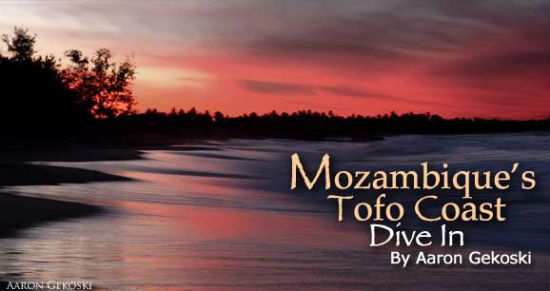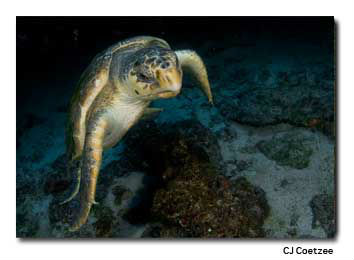

On the surface of it, there is nothing remarkable about Tofo Beach in Mozambique. It has no lavishly furnished stilted bungalows caressed by velvety, crystal clear waters. Instead, concrete boxes masquerading as houses perch on top of sand dunes, cautiously peering down on a sprawling brown beach, which is devoured nightly by a hostile sea. It’s impressive, certainly. But special? Not really. On the surface, that is. However, dive just a little bit deeper and Tofo’s coast may just be the most spectacular in the world.
Less than 20 years ago, Mozambique was declared the poorest country in the world. A savage civil war swept through it. Mozambique imploded. Nearly a million people died — knifed, axed, shot by their own. Many more lost limbs to land mines. It was the darkest period for a country still infused with the pain of a brutal colonization by the Portuguese.
But Mozambicans are amazingly resilient, and, in a remarkable turnaround, the country is now one of Africa’s fastest-growing tourist destinations. Northern Mozambique is pretty postcard land, smeared with endless, impossibly pristine beaches.
Gorongosa’s plains have replenished after they were plucked of their wildlife by the desperate and starving. Now, it vies with Kruger National Park for the title of Southern Africa’s most desirable safari destination. And Maputo, Mozambique’s good-time capital belies the rest of the country’s chilled-out style.
But Mozambique’s most dramatic parties aren’t those held in Maputo’s thumping nightclubs. They are nothing compared to the action beneath the waves. The diving here is amazingly good, particularly along the stretch of beaches in the Inhambane province.
Giant black and white manta rays, resembling massive, squashed cows, glide poetically through the waves. Mantas have the largest brain-to-body ratio of any fish. They are acutely aware of the presence of interlopers, constantly on guard, yet ready under the right conditions to interact with a newfound cylinder-clad chum.
Whale sharks, on the other hand, are not so bright, yet compensate for their slack-jawed dimness by being both very large and very pretty. Congregations of whale sharks, up to 20 strong, endure snorkelers with good nature, obliviously hoovering up vast quantities of plankton. Tofo Beach remains the only place on earth where these jolly blue giants can be seen year-round. And, during winter months, whale sharks seem to diminish in size compared to the arriving — and pregnant — humpbacks, which turn these waters into a whale maternity ward.
This spectacular marine playground is even occasionally frequented by one of the ocean’s most mysterious creatures, the source of the mythical figure of the mermaid. Seen from a distance (perhaps through squinted, salt-encrusted eyes), it is possible to imagine how a dugong could be mistaken for a mermaid: half-woman, half-fish. But, mainly, dugongs — with their bulky, hairless bodies and long snouts — are more reminiscent of gigantic Gonzos, that ugly blue alien from the Muppets. Looks aside, these are majestic mounds of blubber that pay testament to evolution’s incomprehensible ways.
There must be something in the water here. Another giant — the world’s largest marine stingray, the smalleye — has been seen alive only in this stretch of ocean. All of this marine life has led to these terrains being referred to as Tofo’s (aquatic) Big Five. And while the big pelagics may grab the headlines, the macro life isn’t too bad, either. Flamboyant leaf fish, tragically malproportioned frog fish, feisty mantis shrimp and cute, fuzzy orangutan crabs breathe life into sweeping plateaus of soft and hard coral.
For a marine Utopia, Tofo remains largely off the radar of many. One of the reasons could be that getting to and getting around Mozambique is surprisingly problematic. Its visa system, for instance, is perplexingly complicated. A scheme recently implemented by the government means all visitors are required to obtain a photo visa, priced at $80. Being issued with this elaborate, costly stamp is a painstaking process that can take hours on the border.
Maputo’s airport is also eternally “under renovation.” And, once you leave it, Mozambique possesses only one motorway. The rest of the road systems, while improving slowly, are still ill-equipped to serve a stampede of tourists, and a 4×4 remains a must in most parts of the country. Oh, and Mozambique is a malaria hot spot. Suddenly, the nearby Maldives (with its lavishly furnished stilted bungalows) seems a far more attractive and easy option.
Yet, Tofo has remained popular with divers and backpackers, as well as the brew of dreamers, hedonists and misfits that such beach communities seem to attract. And while Tofo has some of the annoying traits of a tourist destination (children selling goods on the beach are a little pushy but can be discouraged with a polite “nao, obrigado”), ultimately it retains its Mozambican charm.
A local market sells excellent fresh fruits and vegetables, as well as the obligatory carved elephants, all at reasonable prices. Due to the strength of the South African rand, eating out has become a bit more expensive, but you can still dine very well with your loose change. Local restaurants, such as Tofo institution Black and White’s, serves up seafood, freshly plucked from the ocean, with rice, salad and a beer for only $3. And Dino’s beach bar is a great place to sip pina coladas, shake your stuff and wait to watch a breaching humpback, silhouetted by a rising sun.
The biggest threat facing Tofo, sadly, is a familiar one. Overfishing has had a dramatic effect on these waters over recent years. Only five years ago, divers could be treated to schools of devil rays 300 thick. Now they are lucky to see 10 at a time. Gigantic, unforgiving walls of gill nets frequently ensnare manta rays.
And, perhaps most worryingly, Mozambique’s sharks are being killed in vast numbers to satisfy a demand from a shark fin-soup-hungry Southeast Asia. This trade has been spreading over Africa’s waters in recent years, with fishermen keen to cash in on the lucrative fins. It is difficult to chastise local fishermen for this practice, though, when shark meat provides a valuable source of protein for these communities. Sadly, though, recent tests have shown that shark meat is laden with toxins such as methylmercury, which in sufficiently large amounts can cause fetal abnormalities and lead to developmental deficits in children.

If You Go
Although local fishing is having an impact on fish populations, the greatest problem, however, lays farther out at sea. Industrial vessels continue to operate with silent efficiency, illegally pummelling these waters, far from tourists’ eyes. The result is that our oceans are being emptied of sharks, and other species are being pushed to the brink of extinction. Whale shark and manta ray populations, while still healthy, have been significantly dented. You are almost as likely to see a mermaid as you are a dugong.
So be quick. Slip into a wetsuit, slap on your goggles and strap on a cylinder, for while this stretch of ocean may currently lay claim to being the world’s best, its reputation hangs on the line of some fishing thread.
And, while you are there enjoying the diving and the beer, you might want to support the local organizations that are trying to save these waters, such as Tofo’s Marine Megafauna Foundation (marinemegafauna.org). After all, you might want to bring your children here one day.
- Why the Kimberley Should Be Your Next Australian Adventure - July 5, 2025
- How We Finally Afforded Our Dream Trip to the Swiss Alps (And You Can Too) - July 5, 2025
- Escape Manhattan for Governors Island - July 5, 2025
